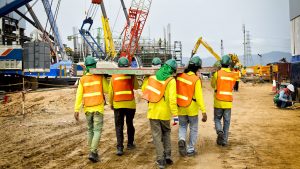A landmark U.S. infrastructure bill is pushing projects forward in ways that vary according to the needs of individual states, according to an economist who specializes in transportation and infrastructure.
American Road and Transportation Builders Association (ARTBA) senior vice-president and chief economist Dr. Alison Black spoke at the Show Me the Money! Where is All the Infrastructure Money Going? session at CONEXPO-CON/AGG in Las Vegas on March 14.
The Infrastructure Investment and Jobs Act (IIJA) was signed into law by President Joe Biden in November 2021 and distributes approximately $1.2 trillion in spending across the country to transportation infrastructure over the next five years.
Black said investment levels rose a record 38 per cent in the first two years and that in order to find a comparable level of infrastructure work one had to go back to the late 1950s.
“This really does reflect the interest of Congress and especially in the Senate when they wrote and approved the bill in making necessary investments in our infrastructure system and really making some headway by putting additional funds towards these important projects,” she said.
Black explained while the federal government provides funding, the individual states decide where investment dollars will go.
“Nine out of every $10 of new funding for highways and bridges in the IIJA is what we call ‘formula dollars’ and that means states have the ability to select the projects where the money is going to go,” Black said.
“They have to be eligible for the federal aid projects, they have to be either interstates or parts of the national highway system, major roads and bridges, not a local road in front of your house. The projects have to qualify but states get to choose their priorities based on their infrastructure needs.”
Black said approximately 90 per cent of the money is being used by states in accordance with their priority infrastructure projects.
While many states are concentrating on highway projects, some are using the funds to upgrade their engineering and software capabilities.
“Federal investment is important because on average it’s about half of all the money supporting state highway and bridge capital investment. Federal funds aren’t the only source of revenue, but they’re a big one, so in Tennessee we see a lot of reconstruction, widening and capacity projects (while) in other states we see more bridge work because that’s where their needs are,” she said.
Black also said her home state of Maryland chose to focus on upgrades, bridge inspections and planning and design work, “all things that are important but that if you’re a contractor in that state looking for projects it’s a different mix than in other areas.”
While an increase in construction work could put pressure on an already strained labour market, Black noted an increase in work before the IIJA was passed indicates the market will be able to handle added capacity.
“In 2013 states began to increase their own investment in transportation, so there was quite a bit of market growth over the next 10 years and we saw jobs added in response to that with wages going up to attract that labour,” she said. “The labour situation can definitely be a challenge in certain regions, but I do point to the fact that those market dynamics worked over the last decade and we would expect that to continue.
“We will see more jobs, but I also think we’ll see investments in different types of productivity, software, new technologies, a lot of which we’re seeing at CONEXPO that will help contractors get more output out of the labour force that they have. I expect more technology that will help the situation as the money is being spent in the next five to 10 years,” Black said.
To hear more from Black, listen to our recent Construction Record Podcast episode from CONEXPO-CON/AGG.











Recent Comments
comments for this post are closed